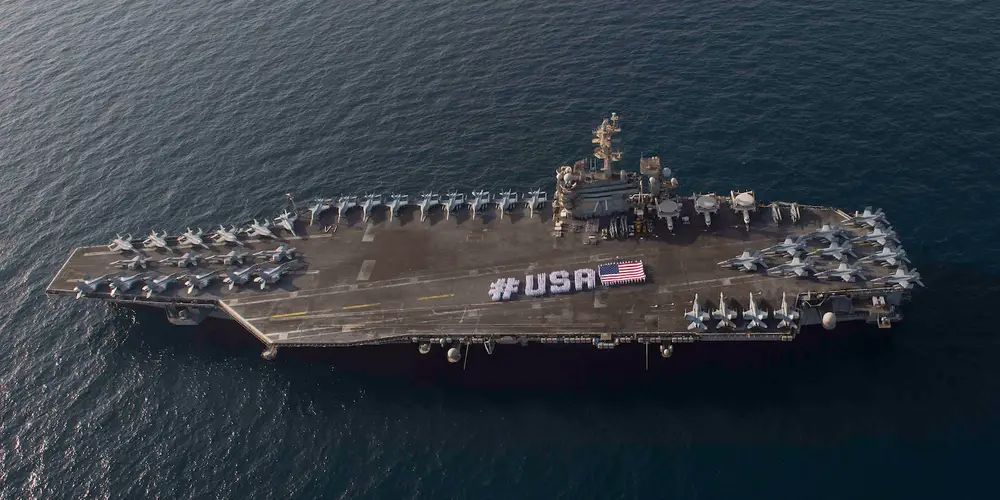The birth of the American Aircraft Carrier stands today as a testament of what an innovative country full of hopeful and determined people, driven by curiosity and national pride, can accomplish over a period of time- when they keep working at their craft.
What started out with a civil test pilot in 1910, strapped up with bicycle inner tubes as floating devices- has become a dominant force in worldwide Navy history, in a 100 year period of time.
Not long after 3 p.m. on Nov. 14, 1910, a pioneering aviator who proved the possibility of shipboard takeoffs lifted off from a cruiser anchored in Hampton Roads.
Civilian test pilot Eugene Ely barely survived his hair-raising plunge into the tops of the waves, which damaged his propeller and drenched his struggling Curtiss pusher biplane with spray.

To where we are today:
No matter where you are in the world the American aircraft carrier serves as the ultimate symbol for the US Navy. They can conduct full-scale military operations for over 70% of the Earth’s surface and have an unequaled ability to provide warfighting capabilities across the full spectrum of conflict.
2022 marks 100 years since the first aircraft carrier.
Celebrating 100 years at the forefront of Naval Aircraft Carrier innovation and excellence.#AircraftCarrierCentennial#FlyNavy pic.twitter.com/0TnAbAioZQ
— U.S. Navy (@USNavy) March 21, 2022
On March 20, 2022, the Navy League kicked off a full-year celebration, in Hampton Roads, for the centennial of the US Navy aircraft carrier, honoring a century of strong sea service to the United States of America.
To mark the day, Rear Admiral John F. Meier, Commander, Naval Air Force Atlantic, wrote a letter:
To All Hands:
As we approach the 100th anniversary of the aircraft carrier it is humbling as we look back on the historical milestones we have accomplished in the name of Naval Aviation. The integration between warfighting aat sea and in the air is no more apparent than on board these magnificent vessels. As the true symbol of the US Navy aircraft carriers are vastly important to maintaining the peace and prosperity of our nation.
The first Aircraft carrier was commissioned in March of 1922 named the USS Langley (CV1), named after Samuel Pierpont Langley (1834-1906), an American astronomer, physicist, and pioneer in the development of heavier-than-air craft. It was the first electric-drive ship, and was described by author Edward Linquist as having gone “from floating fuel farm to first flattop, as the Covered Wagon- it was really a trailblazer.” The Langley started out as the USS Jupiter and was modified and singled out for electric in an era of steam-powered motors.
The aircraft carrier was the start of a new type of seaborn weapon that established the US Navy as a dominant naval force.
#OTD in 1925, Lt. John D. Price, piloting a VF-1 plane, makes a night landing on USS Langley (CV 1), at sea off San Diego, Calif., the first on board a U.S. Navy carrier. #FlyNavy #NavyHistory pic.twitter.com/0dMlBrqhpx
— U.S. Navy (@USNavy) April 8, 2022
Today the USS Gerald R. Ford aircraft carrier is the largest aircraft carrier to ever serve in the U.S. Navy– and is getting close to its first deployment, representing the newest chapter in the 100-year-old story of naval aviation for the United States of America.
#firstinclass of aircraft carriers incorporating 23 new technologies & designed to support the @USNavy's #airwingofthefuture. #WeAreWarship78 #AirPower pic.twitter.com/1ydKnaFc6q
— USS Gerald R. Ford (CVN 78) (@CVN78_GRFord) March 30, 2022
“For 100 years aircraft carriers have been the most survivable and versatile airfields in the world,” Chief of Naval Operations Adm. Michael Gilday said during a Navy League centennial celebration in Norfolk. “Perhaps no single military platform distinguishes what our nation is … and what it stands for … more than the aircraft carrier.”
